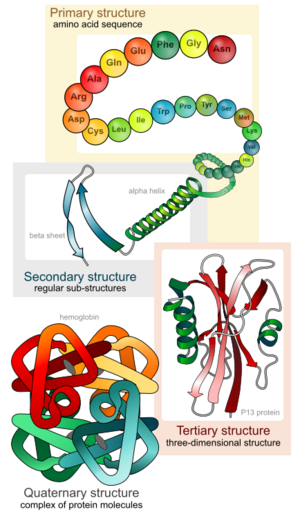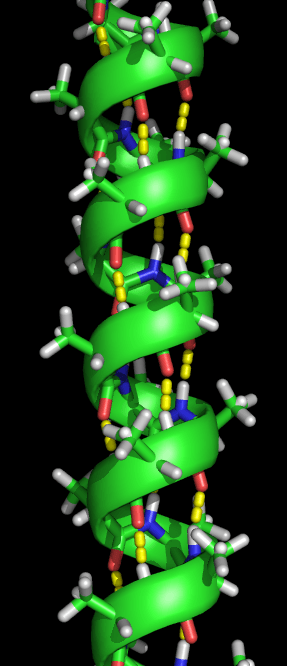Protein structure facts for kids
Proteins are super important molecules found in all living things, from tiny bacteria to humans! They do many jobs, like building parts of your body, helping you digest food, and even fighting off sickness.
Think of proteins as long chains made of smaller building blocks called amino acids. There are 20 different types of amino acids. After these chains are made, they fold up into very specific 3D shapes. This folding isn't just random; it's what makes the protein work! Weaker forces, like hydrogen bonds, help them hold their shape.
Scientists use special tools like X-ray crystallography to figure out these complex 3D shapes. Sometimes, a protein can even change its shape a little bit while it's doing its job. These different shapes are called "conformations." For example, an enzyme (a type of protein that speeds up reactions) might change shape when it connects with other molecules.
Contents
What are the Levels of Protein Structure?
Proteins have four main levels of structure. Each level builds on the one before it, like steps in a staircase.
Primary Structure: The Amino Acid Sequence
Imagine a protein as a long beaded necklace. The primary structure is simply the exact order of the amino acids (the beads) in that chain. Each protein has its own unique sequence. These amino acids are strongly linked together by special connections called peptide bonds. This linking happens when your body makes new proteins.
Secondary Structure: Local Folding Patterns
Once the amino acid chain is formed, parts of it start to fold into regular, repeating patterns. The two most common patterns are:
- Alpha-helix: This looks like a spiral staircase or a coiled spring.
- Beta-sheet: This looks like a folded paper fan, where parts of the chain lie side-by-side.
These patterns are held together by weaker hydrogen bonds between different parts of the amino acid chain. Scientists Linus Pauling and his team first suggested these structures in 1951.
Tertiary Structure: The Overall 3D Shape
The tertiary structure is the complete, overall 3D shape of a single protein molecule. It's how all the alpha-helices, beta-sheets, and other parts of the chain fold together into one unique structure. This folding happens mostly because of the protein's primary structure (its amino acid sequence). This idea is known as Anfinsen's dogma. However, the environment where the protein folds also plays a role in its final shape.
Quaternary Structure: Multiple Protein Units Working Together
Some proteins are made up of several separate protein chains (called subunits) that come together to form a larger, working protein. The quaternary structure describes how these different subunits fit and work together.
A great example is Hemoglobin, the protein in your red blood cells that carries oxygen. Hemoglobin is made of four separate protein chains (two "alpha" chains and two "beta" chains) that join up to do their job.
Images for kids
-
Examples of protein structures from the PDB
See also
 In Spanish: Estructura de las proteínas para niños
In Spanish: Estructura de las proteínas para niños








